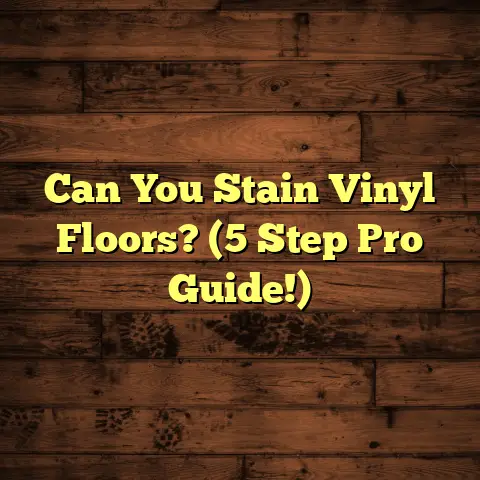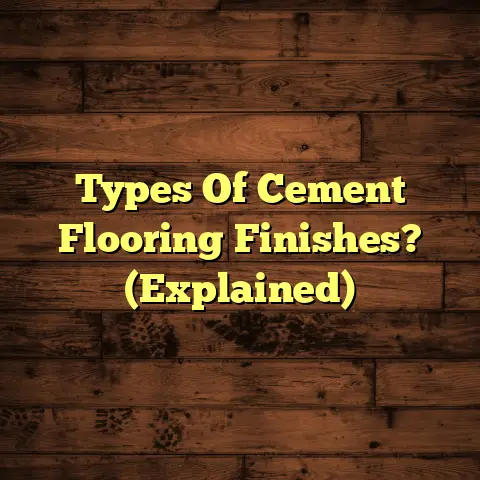Do You Have To Have Quarter Round With Laminate Flooring? (Explained)
When I first decided to install laminate flooring in my home, I felt a mix of excitement and apprehension. The prospect of transforming my living space was thrilling, but I knew it also came with a series of decisions, one of which was whether or not to use quarter round. This seemingly small detail sparked a significant amount of research and contemplation, leading me to discover the multifaceted role that quarter round plays in a flooring installation.
In my own experience, I found laminate flooring to be an excellent alternative to hardwood. It allowed me to achieve the look I desired without the high costs associated with solid wood. I installed a high-quality laminate from a local supplier, costing about $2.50 per square foot for the material alone. For my 1,000-square-foot space, this translated to roughly $2,500 for the flooring.
The Role of Quarter Round
Definition and Purpose
Quarter round is a molding that is typically installed at the junction where the floor meets the wall. Its rounded profile is designed to cover any gaps left during installation due to expansion or contraction of the flooring materials. When I installed my laminate floors, I quickly realized that these gaps could be unsightly and might collect dirt and debris over time.
Aesthetic Considerations
One of the primary reasons I opted for quarter round was its aesthetic contribution. Molding creates a seamless transition between the wall and the floor, enhancing the overall appearance. After installing my laminate without quarter round initially, I noticed that the edges looked unfinished—almost like a raw edge that needed closure. Once I added quarter round, it tied everything together beautifully.
Advantages of Using Quarter Round
Protecting Edges
Quarter round serves multiple practical purposes. One of its most crucial roles is protecting the edges of your flooring. Without it, those edges are exposed to potential damage from furniture, foot traffic, and even cleaning activities. In my case, I had children running around, which made me particularly cautious about wear and tear on my new floors.
Covering Imperfections
No matter how precise your installation is, there will always be minor gaps that can occur due to uneven walls or slight misalignments during installation. Quarter round effectively conceals these imperfections. I remember struggling with one wall in my living room where the baseboards didn’t line up perfectly with the flooring. The quarter round masked this flaw perfectly.
Ease of Maintenance
Another significant advantage I’ve experienced is the ease of maintenance that quarter round provides. Dust and dirt can accumulate in gaps between the flooring and walls if left uncovered. With quarter round in place, I found cleaning became much easier; I could simply wipe along the edges without worrying about debris getting stuck in crevices.
Disadvantages of Using Quarter Round
Additional Costs
While there are many benefits to using quarter round, it does come with additional costs. For my renovation project, the quarter round itself cost about $200 for materials—adding up to my total project cost significantly. If you’re working with a tight budget, this could be a consideration.
Installation Time
Installing quarter round takes extra time. For my project, it added an additional day to measure, cut, and install the molding after laying down the laminate floor. If you’re looking to complete your project quickly, this might be a factor to think about.
Not Always Necessary
In some cases, you may find that quarter round isn’t necessary. If your installation is flawless and you have existing baseboards that are tall enough to cover any gaps adequately, you might skip it altogether. I opted out of using it in my kitchen where custom cabinetry met the floor perfectly.
Exploring Alternatives to Quarter Round
During my flooring journey, I explored various alternatives to quarter round that might also work in different scenarios:
- Baseboard Molding: Taller baseboards can sometimes eliminate the need for quarter round altogether. When I remodeled my dining room, I installed 6-inch baseboards that covered the gap well and provided a more modern look.
- Shoe Molding: Similar to quarter round but flatter in profile, shoe molding might be more suitable for specific styles or preferences. I’ve used shoe molding in other areas of my home; it offers a clean look while being less prominent than traditional quarter round.
- No Molding: In areas where precision cuts were possible and wall-to-floor junctions were tight, such as in my bathroom renovation, I chose to forgo any molding entirely. This created a sleek aesthetic but required careful attention during cutting.
Installation Techniques for Quarter Round
If you decide to go with quarter round for your laminate flooring project, here are some tried-and-true tips based on what I’ve learned:
Tools and Materials Needed
To install quarter round effectively, gather the following tools:
- Miter saw (for angled cuts)
- Tape measure
- Level
- Nail gun (or hammer and finish nails)
- Caulk (for finishing touches)
- Wood filler (for any nail holes)
Measuring and Cutting
Accurate measurements are crucial. Measure the length of each wall where you’ll install quarter round and mark your cuts accordingly. When cutting corners, use a 45-degree angle for inside corners to ensure a snug fit.
I remember making a mistake on my first cut—measuring too short on a piece that met at an outer corner. It meant I had to scrap that piece and start over, which was frustrating but ultimately taught me to double-check before cutting!
Attaching Quarter Round
I found it best to position quarter round directly against the wall with its bottom edge resting on the floor. Using a nail gun made securing it much faster than using a hammer and nails.
If you’re using adhesive instead of nails, ensure both surfaces are clean before applying it for better adhesion. After securing it in place, I always took an extra minute to check with a level to ensure everything looked straight and true.
Finishing Touches
Once installed, fill any visible nail holes with wood filler and sand them smooth once dry. Caulk along the top seam between the molding and wall for a finished look; this can help hide any minor imperfections in alignment while also preventing moisture from seeping behind.
Maintenance of Quarter Round
Maintaining your quarter round is relatively straightforward:
- Regular Cleaning: Dusting along the edges regularly helps prevent buildup.
- Cleaning Products: Use gentle cleaning products suitable for your specific molding material—whether wood or composite—to avoid damage.
- Inspect for Damage: Periodically check for any signs of wear or damage, especially if you have pets or children.
In my experience, keeping an eye on these details makes all the difference in preserving the look and integrity of your flooring project.
Conclusion
As I reflect on my laminate flooring journey and the decision to use quarter round molding, I can confidently say that it was worth it for me. The aesthetic appeal it provided transformed my space from ordinary to extraordinary while offering practical benefits such as protection and ease of maintenance.
While there are pros and cons associated with using quarter round—like added costs and installation time—the advantages often outweigh these factors if you’re looking for a complete finish. Exploring alternatives like taller baseboards or shoe molding may also yield great results depending on your style preferences and project needs.
Every home is unique, and so are every homeowner’s needs and budgets. In my case, incorporating quarter round into my laminate flooring installation enhanced both functionality and beauty in ways that were well worth the investment.
If you’re on the fence about including quarter round in your flooring project, consider your specific circumstances—budget constraints, aesthetic desires, and functional needs—and make an informed decision that will lead to satisfaction in your finished space!





